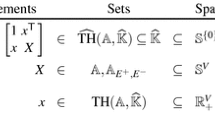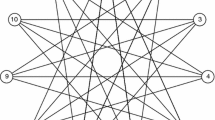Abstract
The paper is concerned with the ‘primal’ problem of maximizing a given quadratic pseudo-boolean function. Four equivalent problems are discussed—the primal, the ‘complementation’, the ‘discrete Rhys LP’ and the ‘weighted stability problem of a SAM graph’. Each of them has a relaxation—the ‘roof dual’, the ‘quadratic complementation,’ the ‘continuous Rhys LP’ and the ‘fractional weighted stability problem of a SAM graph’. The main result is that the four gaps associated with the four relaxations are equal. Furthermore, a solution to any of these problems leads at once to solutions of the other three equivalent ones. The four relaxations can be solved in polynomial time by transforming them to a bipartite maximum flow problem. The optimal solutions of the ‘roof-dual’ define ‘best’ linear majorantsp(x) off, having the following persistency property: if theith coefficient inp is positive (negative) thenx i=1 (0) in every optimum of the primal problem. Several characterizations are given for the case where these persistency results cannot be used to fix any variable of the primal. On the other hand, a class of gap-free functions (properly including the supermodular ones) is exhibited.
Similar content being viewed by others
References
B. Aspvall, M.F. Plass and R.E. Tarjan, “A linear-time algorithm for testing the truth of certain quantified Boolean formulas”,Information Processing Letters 8 (1979) 121–123.
M.L. Balinski, “Integer programming: Methods, uses, computation”, in: G.B. Dantzig and A.F. Veinott, Jr., eds.,Mathematics of the decision sciences, Part I (American Mathematical Society, Providence, 1968), pp 179–256.
M.L. Balinski, “Notes on a constructive approach to linear programming”, in: G.B. Dantzig and A.F. Veinott, Jr., eds.,Mathematics of the decision sciences, Part I (American Mathematical Society, Providence, 1968) pp. 38–64.
S. Cook, “The complexity of theorem proving procedures”,Proceedings of the Third Symposium of the Association of Computing Machinery on the Theory of Computing (1971) 151–158.
M.L. Fischer, G.L. Nemhauser and L.A. Wolsey, “An analysis of approximations for maximizing submodular set functions—I”,Mathematical Programming 14 (1978) 265–294.
D.R. Fulkerson, A.J. Hoffman and M.H. McAndrew, “Some properties of graphs with multiple edges”,Canadian Journal of Mathematics 17 (1965), 166–177.
G. Gallo, P.L. Hammer and B. Simeone, “Quadratic knapsack problems”Mathematical Programming Studies 12 (1980) 132–149.
P.L. Hammer, “Boolean elements in combinatorial optimization”,Annals of Discrete Mathematics 4 (1979) 51–71.
P.L. Hammer and P. Hansen, “Logical relations in quadratic 0–1 programming”,Revue Roumaine de Mathématiques Pures et Appliquées 26 (1981) 421–429.
P.L. Hammer, P. Hansen and B. Simeone, “Vertices belonging to all or to no maximum stables sets of a graph”,SIAM Journal on Algebraic and Discrete Methods 3 (1982) 511–522.
P.L. Hammer, P. Hansen and B. Simeone, “Upper planes of quadratic 0–1 functions and stability in graphs”,Nonlinear Programming 4 (Academic Press, New York, 1981), pp. 395–414.
P.L. Hammer, U.N. Peled and S. Sorensen “Pseudo-boolean functions and game theory, I, Core elements and Shapley value”,Cahiers du Centre d'Etudes de Recherche Opérationnelle 19 (1977) 159–176.
P.L. Hammer and I.G. Rosenberg, “Linear decomposition of a positive group-boolean function”, in: L. Collatz and W. Wetterling, eds.Numerische Methoden bei Optimierung Vol. II (Birkhäuser, Basel and Stuttgart, 1974) pp. 51–62.
P.L. Hammer and S. Rudeanu,Boolean methods in operations research and related areas (Springer, Berlin, New York, 1968).
P. Hansen, “Fonctions d'évaluation et pénalites pour les programmes quadratiques en variables 0–1”, in: B. Roy, ed.Combinatorial programming, methods and applications, (Reidel, Dordrecht, 1975) pp. 361–370.
P. Hansen, “Labelling algorithms for balance in signed graphs”, in: J.-C. Bermond et al., eds.,Problèmes combinatoires et théorie des graphes, Colloque International du Centre National de la Recherche Scientifique, No. 260 (Editions Centre National de la Recherche Scientifique, Paris, 1978) pp. 215–217.
P. Hansen, “Methods of nonlinear 0–1 programming”,Annals of Discrete Mathematics 5 (1979) 53–69.
P. Hansen and B. Simeone, “A class of quadratic pseudoboolean functions whose maximization is reducible to a network flow problem,” CORR 79-39, Department of Combinatorics and Optimization, University of Waterloo, (Waterloo, Ontario, 1979).
E.L. Lawler,Combinatorial optimization: Networks and matroids (Holt, Rinehart and Winston, New York, 1976).
E.L. Lawler, “Shortest path and network flow algorithms”,Annals of Discrete Mathematics 4 (1979) 251–263.
G.L. Nemhauser and L.E. Trotter, “Vertex packings: Structural properties and algorithms”,Mathematical Programming 8 (1975) 232–248.
J.C. Picard and M. Queyranne, “On the integer valued variables in the linear vertex packing problem”,Mathematical Programming 12 (1977) 97–101.
J. Rhys, “A selection problem of shared fixed costs and networks”,Management Science 17 (1970) 200–207.
I.G. Rosenberg, “Reduction of bivalent maximization to the quadratic case”,Cahiers du Centre d'Etudes de Recherche Opérationnelle 17 (1975) 71–79.
B. Simeone, “Quadratic 0–1 programming, boolean functions and graphs”, Doctoral Dissertation, University of Waterloo (Waterloo, Ontario, 1979).
B. Simeone, “A generalizaed consensus approach to non-linear 0–1 optimization”,Journal of the Association of Computing Machinery, forthcoming.
Author information
Authors and Affiliations
Rights and permissions
About this article
Cite this article
Hammer, P.L., Hansen, P. & Simeone, B. Roof duality, complementation and persistency in quadratic 0–1 optimization. Mathematical Programming 28, 121–155 (1984). https://doi.org/10.1007/BF02612354
Received:
Revised:
Issue Date:
DOI: https://doi.org/10.1007/BF02612354




